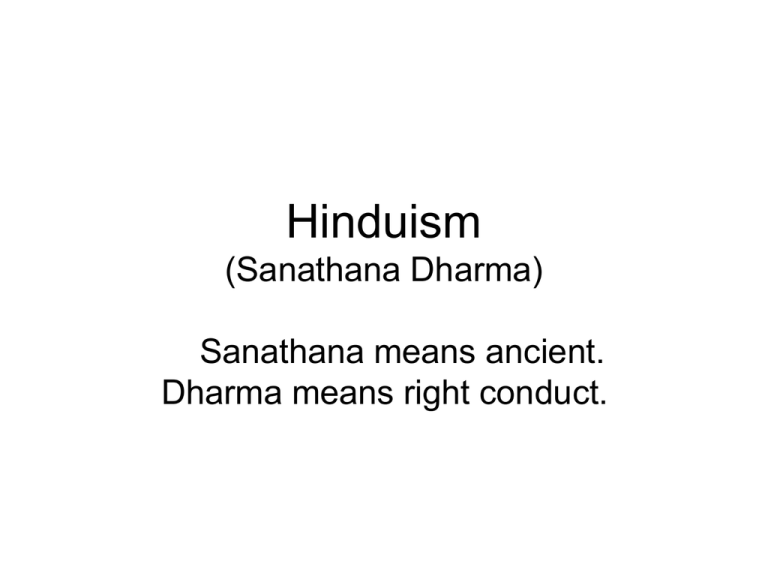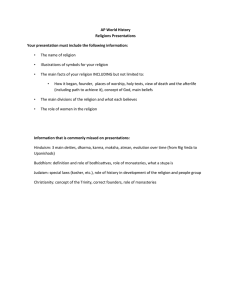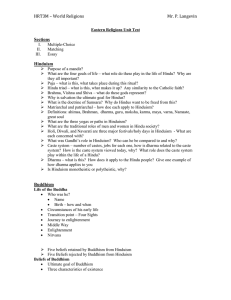Hinduism (Sanathana Dharma)
advertisement

Hinduism (Sanathana Dharma) Sanathana means ancient. Dharma means right conduct. Origin of the word Hinduism • People living in the Indus Valley. • Later became Hindus. • Religion became Hinduism. Uniqueness of Hinduism • Caters to the needs of all people. • Accepts all religions and all paths. • Considers scriptures to be a road map to facilitate spiritual journey. • Believes all creations and all creatures are forms of God. • Does not believe in conversion of people of one religion to another. • Does not have a founder or a book. Swami Vivekananda • “I am proud to belong to a religion which has taught the world both tolerance and universal acceptance. We believe not only in universal tolerance, but we accept all religions as true. As different streams having different sources all mingle their waters in the sea, so different paths which men take through different tendencies various though they appear, crooked or straight, all lead to God.” Goal of life • To know: – Who we are – Where we have come from – To become one with our source – To realize our full potential – To become one with Brahman – Moksha: Self-realization, liberation, or bliss. Four Paths • 1. Bhakti Yoga: – Listening to stories of glories of God – Singing praises of God – Reciting the name of God – Worshipping God – Saluting God – Friendship with God – Total surrender to God Four Kinds of Devotees • One who calls upon God when in trouble • One who prays for material wealth and power • Seeker of knowledge • Seeker of self-realization 2. Karma Yoga • Path of selfless service- to work for the good of humanity. • Non-attachment to fruits of action • Purity of heart- surrendering the fruits to God 3. Gnaana Yoga- Path of Knowledge • Four practices: – Discrimination (real vs. unreal) – Detachment from unreal – Six wealths: serenity of mind, control of senses, mind control, intensity of endurance, faith, one-pointedness of mind, strong yearning for liberation 4. Raja Yoga- Path of Contemplation • Patanjali Astaanga Yoga- Eight paths of contemplation – – – – – – – Yama- responsible restraint Niyama- purification Asana- postures Pranaayama- regulation of breathing Pratyaahara- drawing senses inwards Dhaarana- concentration for 12 seconds Dhyaana- meditation, 12 dharana- 12x12= 144 seconds Three Levels of Progression - the three philosophies • Dwiita: Dualism- Karma Yoga- “I am in the Light”, “Messenger of God”. • Visistadwaiita: Qualified non-dualismBhakti Yoga- “Light is in me”, “Son of God”. • Adwiita: Non-dualism- Gnaana Yoga- “I am the Light”, “I and my Father are one”. Shri Ramakrishna • “When I think of myself as identified with the body, I am thy servant and thou art my master, my will is controlled by thy will.” • “When I think of myself as a Jiva (individualized soul) as distinct from the body, I am the part and thou art the whole.” • “When I recognize the spiritual principle in me as distinct from body and mind and Jiva, I realize that I am one with the Divine.” Two Levels of Contemplation • Form: – Contemplation with form – Contemplation without form Four Goals of Life • Dharma: right conduct or righteousness • Artha: acquisition of worldly possessions and wealth • Kaama: satisfying desires for sense pleasures • Moksha: liberation achieved through God realization. Four Stages of Hindu Life • Brahmacharya: the stage of student • Gaarhasthya: the stage of householder or family life. • Vaanaprastha: the stage of retired person or hermit • Sannyasa: the stage of monk or renounciate. Dharma, the concept of Hindu Ethics • Dharma means moral or ethical duty. • There are several levels of Dharma: – Individual Dharma – Family Dharma – Societal Dharma – National Dharma – Dharma of Mankind – Dharma of Cosmos (controlled by God) Dharma, the Concept of Hindu Ethics (cont.) • One can sacrifice lower Dharma for the sake of higher Dharma, but not vice versa. For example, Buddha sacrificed Dharma of his family for the sake of higher Dharma to the Mankind. Hence, it was acceptable. It is not acceptable to sacrifice the Society for the sake of Family. One’s own Conscience, Nature, and Scriptures tell us about the correct Dharma at a given time. Doctrine of Karma- Law of Cause and Effect • Every action has a reaction. Every act has an effect either in this life or in future lives. Good actions will have good effects, and bad actions will have bad effects. Doctrine of Destiny- Pre-determination of Events in this Life from Previous Actions • The past actions that are producing results in this life. • Today’s actions that will produce results in future lives. • Among these three kinds of actions, the selfrealized souls can wipe off all actions or the results of the actions: salvation. • The actions of the past lives are to produce results at a future date. Doctrine of Free Will • Out of the 8,400,000 species of God’s creation, only Humans have free will to discover their source. • So long as one has body consciousness, one has free will, for which he reaps the fruits. • Divine consciousness without ego; surrendering actions to God wipes off the results of action. God’s Grace • God’s Grace is equal on all of creation. He is never partial. He is only a witness. His grace is like the wind, we are like the boats in the ocean. • Devotee is a receiving instrument while God is the transmitting station. • God’s Grace is like sunshine that shines equally on everybody. Theory of Reincarnation • After death the gross body mixes with the five elements. The subtle body, consisting of senses, mind, intellect, and vital energy along with the causal body, the Soul goes to a different plane of existence. Theory of Reincarnation (cont.) • 14 such planes are described: Sathya Loka, Tapo Loka, Mahar Loka, Gnaana Loka, Svar Loka, Bhuvar Loka, Bhu Loka, Bhur Loka, Atala Loka, Vitala Loka, Sutala Loka, Rasaatala Loka, Talaatala Loka, Mahaatala Loka, Pataala Loka. • Among these, 6 are higher planes of existence, 7 are lower planes. Theory of Reincarnation (cont.) • The departed soul goes to the higher or lower lokas and go through either pleasure or suffering, depending on their good or bad karma respectively on earth. Theory of Reincarnation (cont.) • Reincarnation: when a person dies with strong unfulfilled desires, he will be reborn on this earth after he completes the karma phala in other lokas. • Reincarnation is also an opportunity to evolve to full potential of human birth, i.e. Self-Realization. After this, he will have no more pent up desires, hence no rebirth. He will be liberated and be one with totality. Trigunas: Creation • World is Ardha Nareeswara Swarupam- a combination of Spirit and Matter. The spirit is Purusha or Shiva and the Matter is Prakriti or Shakti. Shiva is the potential energy, while Shakti is kinetic energy. If Shiva is electricity, Shaki is magnetic force. Trigunas: Creation (cont.) • Prakriti is composed of three intertwined subtle natures compared to the three strands of rope. These substances are called Gunas. They are: Sattwa Guna, Rajo Guna, and Tamo Guna. Before the dawn of manifest world of plurality and diversity is created from unity, these three Gunas are in perfect balance and harmony. When the state of harmony is lost, the world of diversity is created. Trigunas: Creation (cont.) • Tamo Guna is inertia, inactivity, dull and stabilizing quality represented by Black. • Rajo Guna is represented by activity, represented by Red. • Sattwa Gun is light, evolving and elevating force represented by White. Trigunas: Creation (cont.) • While Tamo Guna causes confusion and causeless violence, • Rajo Guna causes restlessness and bondage through attachment to the fruits of action, • Sattwa Guna gives spiritual progress. • Going above the three Gunas gives ultimate liberation. Concept of Maya- the Illusionary Force of Creation • This illusionary force is created by God, which prevents the experience of God, as sun creates clouds and the clouds cover the sun from view. • In order for the One to appear as many, the illusionary force was created at the beginning of creation. This illusionary force is called Maya. Concept of Maya (cont.) • Mala: clouding due to impurities. Cleared by selfless actions. • Vikshepa: agitations in mind. Cleared by Bhakti and Raja Yoga. • Aavarana: veiling and covering. Cleared by Gnaana Yoga. Five Sheaths in Humans • • • • • Food Sheath: gross body Vital Energy Sheath: subtle body Mind Sheath: subtle body Knowledge Sheath: subtle body Bliss Sheath: causal body Eternal Cycle • Cosmos is in an eternal cycle of Unity to Diversity to Unity. From God that is Unity, three gunas- Maya, five subtle elements (space, air, fire, water, earth)- five gross elementsinanimate-animate-plants-aquatic animalsamphibians-birds-animals-and ultimately humans to God, the Unity again. Among the creation, humans are the only ones that have the capability to become one with God, since they are the precursors of divinity. Eternal Cycle (cont.) • Hiranya Garbha (Brahma) is created from God as the embodiment of cosmic creative intelligence from His thought…The lifetime of Hiranyagarbha is called Mahakalpa – Krita Yuga (1,728,000 human years) – Treta Yuga (1,296,000 human years) – Dwaapara Yuga (864,000 human years) – Kali Yuga (432,000 human years) – Maha Yuga (4,320,000 human years) Eternal Cycle (cont.) • One Maha Yuga is supposed to be half a day (12 hours) for Hirnyagarbha and he is said to live for 100 years. And then he merges into God. At the end of one cycle of Hiranyagarbha, the world undergoes dissolution and this is called Maha Pralaya. Spiritual Sadhana- Spiritual Journey • Spirituality is an uncovering, evolving, spontaneous process. All creatures and creation are in this journey from the day they were born until the day they die. They will not rest and be fully happy until they reach the goal of becoming one with God. The difference between one and the other is that each one is at a different station on this road, some ahead, and some behind, and ultimately they will all reach the same destination. Spiritual Sadhana- Spiritual Journey (cont.) • Hinduism talks about six hurdles in this path. – Sathya (truth) – Dharma (right conduct) – Shanthi (peace) – Prema (love) – Ahimsa (non-violence in thought, word, and deed) – Thyaga (sacrifice, selflessness) Hindu Scriptures- Sruti Literature • Vedas (1200-900 B.C.): – Rig Veda, Yajur Veda, Sama Veda and Atharvana Veda • Major Upanishads: – Isa, Kena, Katha, Prasna, Mundaka, Mandukya Aitareya, Taittiriya, Chandogya, Brihadaranyaka, Kaushitaki, Maitri Hindu Literature- Smriti Literature • Smritis (900-500 B.C.): Manu Smriti, Gautama Smriti, Yajnavalkya Smriti • Vedangas: Siksa, Vyakarana, Chandas, Nirukta, Jyotisha, Vastu, Panchangam, Kalpa. (Dharma Sutras, Astronomy, Astrology, Grammar, Rituals) • Darsanas: Nyaya, Vaiseshika, Samkhya, Yoga, Purva mimamsa, Uttara mimamsa Vedanta. (Brahama Sutras, Patanjali yoga Sutras) • Ithihasa (900 B.C.): Ramayana Mahabharata (Bhagavad Geeta) • Puranas: Agni, Bhagavata, Bhavishya, Brahma, Brahmanda, Brahmavaivarta, Garuda, Harivamsha, Kurma, Linga, Markandeya, Matsya, Narada, Padma, Skanda, Siva, Vamana, Varaha, Vayu, Vishnu • Upavedas: Material added to the Vedas- Ayurveda (added to the Atharvana Veda), Arthasastra (added to Rig Veda), Dhanurveda (added to Yajur Veda), Gandharvaveda (added to Sama Veda) • Tantras: Mantras, Yantras, Mandalas, Cosmograms, Mudras, Kundalini Power, Sexo-Yogic Exercises, Bhandhas • Agamas: Vaishnava Agamas (Vishnu Samhita), Saiva Agamas, Shakti Agamas • Upangas: Logical & Ritualistic forms of thought • Siddhantas: Dwiita, Visistadwiita, Adwiita Hindu Scriptures- Prasthanatraya • Bhagavad Geeta (500-200 B.C.) • Upanishads • Brahama Sutras (500 B.C. - 500 C.E.) Hindu Caste System • Brahman: scholars • Kshatriya: warriors • Vaishya: traders • Shudra: servants (the conquered people) Similarities to Greek mythology Hercules (Herakles) fighting the Lernaean Hydra Krishna (Harekrsna) fighting the Kaliya Serpent Similarities to Greek mythology Dionysus (Dionysos) holding a Trident Dionysus (Dionysos) encircled with a snake, with leopard by his side, with the moon in the background, his abode is Mount Olympus Shiva, holding the Trident, resting on a leopard skin with a Cobra perched beside him, his abode is Mount Kailas, Himalayas Similarities to Biblical mythology The ancient Vedic Aryan Hindus (Indus Saraswati) spoke about a series of Ten Pitris who ruled before the global Flood. Ancient Babylonian legend speaks of a pre-Flood series of ten kings. The ancient Egyptians described Ten Shining Ones who ruled consecutively before the Deluge. The last of these kings in the aforementioned lists was the hero who led seven others aboard a vessel in which they survived the global Flood. In ancient India, the hero was Manu who survived the global-Flood "pralaya" with the Seven Rishis. In ancient Babylon, the hero's name was Zisudra who spear-headed the survival on the Ark of seven other humans, the Seven Apkallu. In ancient Egypt, the Flood hero was Toth who survived the Deluge along with the Seven Sages. Did the Vedic Aryans travel as far as Easter Island? The Easter Islands located in the Pacific Ocean, were situated far away from any civilization. The craftsmanship of these islands corresponds to the one of the ancient Incas. The sign script of the Easter Islands almost equals the ancient scripts of Indus Valley. Easter Island symbols Indus Saraswati symbols Were the Ancient Vedic civilisation of Indus Saraswati valley Trans-Oceanic seafarers? 1 Billion people, 1 Billion Gods Lakshmi Buddha Krsna Christ Saraswati Murugan Nanak Rama Devi SARASWATI Ganesha Bibliography • • • • • • • • • • • • • • • Armstrong, D.M. Belief, Truth and Knowledge. London, Cambridge University Press, 1973. Borst, C.V. The Mind-Brain Identity Theory. London, Macmillan, 1970. Campbell, Joseph. The Power of Myth. New York, Doubleday, 1988. Ed. by Christopher Isherwood. Introduction to Vedanta for the Western World. N.Y., Viking, 1960. Edwards, Mike. “Indus Civilization: Clues to Ancient Civilization”, National Geographic. V. 197, #6, June 2000. Ghose, Aurobindo. The Secret of the Veda. Pondicherry, Sri Aurobindo Ashram, 1971. Ghose, Aurobindo. The Synthesis of Yoga. Pondicherry, India: Sri Aurobindo Ashram, 1973. Hoppe, L.M. Religions of the World, 8th ed. Prentice Hall, Upper Saddle Valley, NY, 2001. Kinsley, David R. Hindu goddesses: Visions of the Divine Feminine in the Hindu Religious Tradition. Berkeley, University of California Press, 1986. Klostermaier, Klaus K. A Survey of Hinduism. Albany, N.Y. State University, 1989. Klostermaier, Klaus K. Mythologies and Philosophies of Salvation in the Theistic Traditions of India. Waterloo, Ontario, Canada, 1984. Prasad, Raghavendra S. Hinduism. TANA Conference, Los Angeles, CA, 1985. Spratt, Philip. Hindu Culture and Personality: A Psycho-Analytic Study. Bombay, Manaktalas, 1966. Zimmer, Heinrich Robert. Myths and Symbols in Indian Art and civilization. New York, Pantheon Books, 1946. http://www.utc.edu/Faculty/Sarla-Murgai/MeraBharatIndiaMahan.ppt








